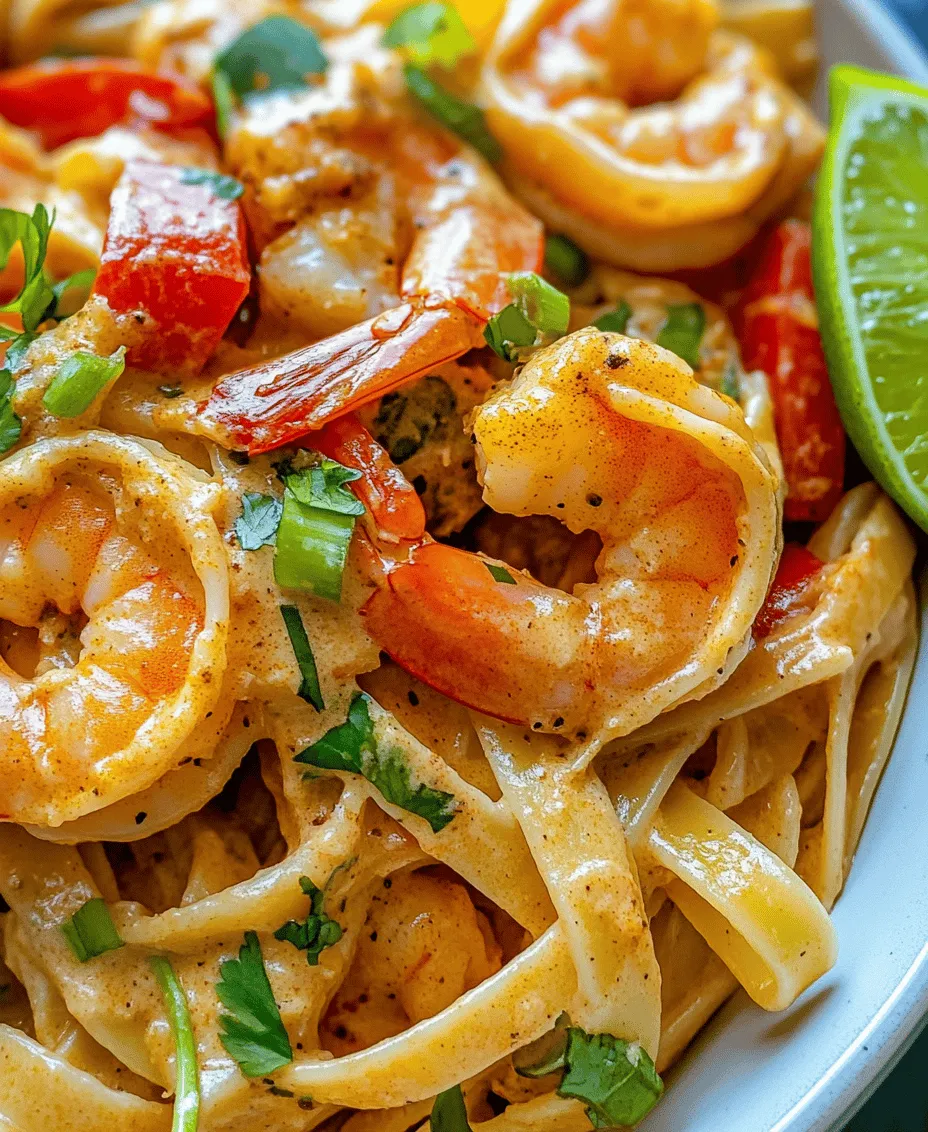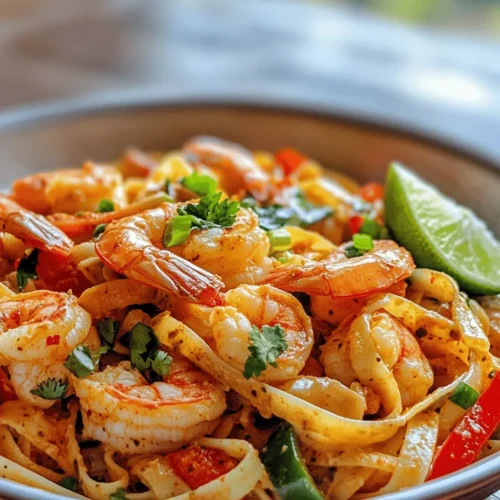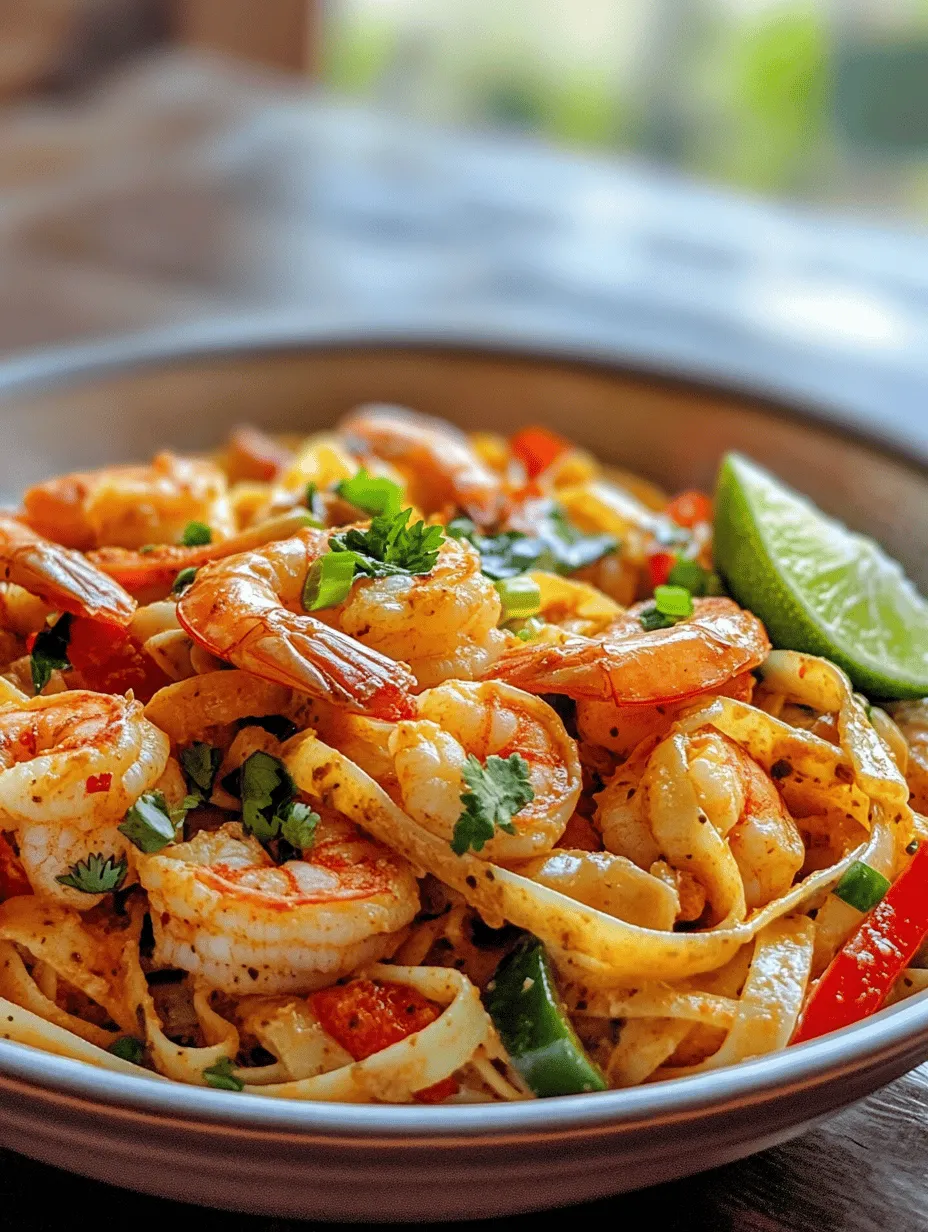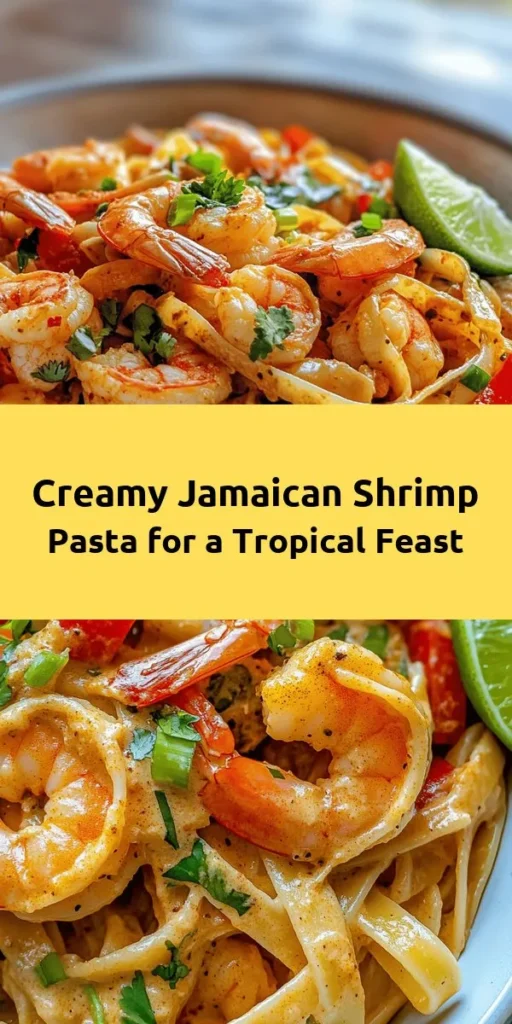When it comes to food that tantalizes the taste buds and warms the soul, few cuisines can compete with the vibrant flavors of Jamaican cooking. Known for its bold spices, fresh ingredients, and rich cultural heritage, Jamaican cuisine has a unique ability to transform even the simplest of dishes into something extraordinary. One such dish that perfectly embodies this fusion of flavors is Jamaican Shrimp Pasta. This delightful recipe marries the creamy richness of coconut milk and heavy cream with the fiery kick of jerk seasoning, all enveloping succulent shrimp and al dente fettuccine. Whether it’s for a special celebration or a cozy family dinner, Jamaican Shrimp Pasta offers versatility and a flavor explosion that is sure to impress.
Exploring the Flavors of Jamaica
At the heart of Jamaican cooking lies a rich tapestry of influences, including indigenous Taíno traditions, African heritage, and European colonialism. These diverse elements come together to create a cuisine that is as colorful and vibrant as the island itself. One of the defining elements of Jamaican food is its use of spices, particularly jerk seasoning.
Jerk seasoning originated among the Maroons, descendants of enslaved Africans who escaped plantations and developed their own culture and cooking styles in the Jamaican mountains. This seasoning typically features a blend of allspice, Scotch bonnet peppers, thyme, garlic, and ginger, creating a smoky, spicy, and aromatic profile. The use of jerk seasoning in Jamaican Shrimp Pasta not only enhances the flavor of the shrimp but also pays homage to the island’s culinary roots, making this dish a perfect representation of Jamaica’s food heritage.
Understanding the Ingredients
Creating a mouthwatering Jamaican Shrimp Pasta requires a selection of high-quality ingredients. The interplay of flavors and textures in this dish is what sets it apart, making it essential to understand the role each ingredient plays.
Main Ingredients Overview
The success of Jamaican Shrimp Pasta hinges on a handful of main ingredients. Each component contributes to the overall flavor, texture, and nutritional value of the dish. Here’s a closer look at what you’ll need:
1. Fettuccine Pasta
2. Shrimp
3. Onions
4. Garlic
5. Bell Peppers
6. Jamaican Jerk Seasoning
7. Coconut Milk
8. Heavy Cream
9. Parmesan Cheese
Fettuccine Pasta
Fettuccine is a flat pasta that’s well-suited for creamy sauces, making it an excellent choice for this dish. Its broad surface area allows it to capture and cling to the rich sauce, ensuring each bite is filled with flavor. The chewiness of fettuccine balances the creaminess of the sauce, creating a satisfying mouthfeel that enhances the overall dining experience.
Shrimp: The Star Ingredient
Shrimp is undeniably the star of this dish. Not only does it provide a succulent protein source, but it also absorbs the flavors of the jerk seasoning and creamy sauce beautifully. When selecting shrimp for your pasta, consider the following tips:
– Freshness: Opt for shrimp that has a mild, briny scent. If buying frozen shrimp, ensure they are properly stored and show no signs of freezer burn.
– Size: Large or extra-large shrimp work best for this recipe, as they hold up well during cooking and deliver a satisfying bite.
– Type: Look for wild-caught shrimp when possible. They tend to have better flavor and texture compared to farmed varieties.
Shrimp is not only delicious but also packed with health benefits. It is low in calories, high in protein, and contains essential nutrients like iodine and selenium. Plus, its versatility makes it a favorite in a variety of cuisines around the world.
The Aromatics: Onions and Garlic
Onions and garlic form the backbone of many culinary dishes, and Jamaican Shrimp Pasta is no exception. These aromatics create a flavor base that enhances the dish’s overall taste profile.
– Onions: When cooked, onions become sweet and caramelized, adding depth to the dish. For this recipe, yellow or sweet onions work well, providing a mild flavor that complements the spiciness of the jerk seasoning.
– Garlic: Known for its pungent aroma and rich flavor, garlic adds a layer of complexity to the sauce. Sautéing garlic until fragrant before adding other ingredients allows its essential oils to infuse the dish, creating a robust flavor foundation.
Bell Peppers: A Splash of Color and Nutrients
Adding bell peppers not only contributes a vibrant splash of color to the dish but also enhances its nutritional profile. Red and green bell peppers are rich in vitamins A and C, as well as antioxidants. Their crispy texture offers a delightful contrast to the creamy sauce and tender shrimp.
When preparing the bell peppers, slice them into strips or bite-sized pieces. This allows them to cook evenly and meld seamlessly with the other ingredients, ensuring you enjoy their sweetness in every bite.
Jamaican Jerk Seasoning: A Flavor Powerhouse
No discussion of Jamaican cuisine would be complete without mentioning jerk seasoning. This aromatic blend of spices and herbs is essential for adding that signature Jamaican flavor to the shrimp.
– Ingredients: The typical components of jerk seasoning include allspice (pimento), Scotch bonnet peppers, thyme, scallions, garlic, and ginger. Each ingredient contributes to the overall complexity of the seasoning, providing a balance of heat, sweetness, and earthiness.
– Flavor Profile: The result is a bold and spicy seasoning with a hint of sweetness and smokiness that elevates the shrimp to new culinary heights. In Jamaican Shrimp Pasta, the jerk seasoning permeates the shrimp and infuses the entire dish with its distinct taste.
Coconut Milk and Heavy Cream: Creaminess Defined
The rich and creamy sauce in Jamaican Shrimp Pasta is achieved through a luxurious combination of coconut milk and heavy cream.
– Coconut Milk: This ingredient adds a subtle sweetness and tropical flair to the dish. Its creamy texture helps to mellow the heat of the jerk seasoning, creating a harmonious balance of flavors. Coconut milk is also a staple in Jamaican cooking, further enhancing the authenticity of this dish.
– Heavy Cream: To achieve ultimate creaminess, heavy cream is added to the coconut milk. It provides a velvety texture that clings to the pasta and shrimp, making every bite indulgent and satisfying. The combination of these two creamy ingredients creates a sauce that is both rich and comforting.
Parmesan Cheese: A Touch of Umami
To finish off the dish, a sprinkle of freshly grated Parmesan cheese is added. This Italian cheese brings a savory umami flavor that beautifully complements the creaminess of the sauce.
Parmesan cheese not only enhances the richness of the dish but also adds a delightful salty note that balances the sweetness of the coconut milk. When selecting Parmesan, opt for a high-quality, aged cheese for the best flavor. Grating it fresh just before serving ensures that you get the full depth of its taste and aroma.
In summary, Jamaican Shrimp Pasta is a culinary masterpiece that beautifully blends the vibrant flavors of Jamaica with classic Italian elements. With its creamy sauce, tender shrimp, and perfectly cooked fettuccine, this dish is perfect for any occasion. Whether you’re entertaining guests or enjoying a quiet family dinner, this recipe is sure to impress and delight. The combination of high-quality ingredients, bold flavors, and a touch of cultural heritage makes Jamaican Shrimp Pasta a must-try for any food lover.
Stay tuned for the next part of this article, which will provide step-by-step instructions on how to bring this delicious dish to life in your kitchen!

Cooking Jamaican Shrimp Pasta: Step-by-Step Instructions
Preparing the Pasta
To create the perfect base for your Jamaican Shrimp Pasta, it’s essential to cook the fettuccine to al dente perfection. Begin by bringing a large pot of water to a rolling boil. Adding salt is crucial; aim for a ratio of about 1-2 tablespoons of salt per gallon of water. This not only seasons the pasta but also enhances its flavor.
Once the water is boiling, add the fettuccine. Stir occasionally to prevent sticking and ensure even cooking. Check the pasta packaging for recommended cooking times, but typically, fettuccine takes around 8 to 10 minutes to reach al dente. You want it to be firm to the bite yet cooked through, so start tasting it a minute or two before the package time is up. Once done, drain the pasta in a colander but reserve about a cup of the pasta water. This starchy water can be a lifesaver for adjusting your sauce later.
Sautéing the Aromatics
While the pasta is cooking, it’s time to prepare the aromatics. Heat a large skillet over medium heat and add a drizzle of olive oil. Once the oil shimmers, add finely chopped onions. Sauté them for about 3-4 minutes until they become translucent but not browned. This step is vital; burning the onions can impart a bitter taste to your dish.
Next, add minced garlic to the skillet and sauté for an additional minute. The goal here is to extract maximum flavor without burning the garlic, which can happen quickly. Stir the mixture constantly and watch for the aromatic scent that signals it’s ready for the next step. Properly sautéed onions and garlic will form the flavor foundation for your creamy shrimp sauce.
Cooking the Shrimp and Peppers
Now, it’s time to introduce the star of the dish: the shrimp. For this recipe, use fresh or thawed shrimp, peeled and deveined. Season the shrimp lightly with salt and pepper before adding them to the skillet. Increase the heat to medium-high and cook the shrimp for about 2-3 minutes on each side, or until they turn pink and opaque. Overcooking shrimp can result in a rubbery texture, so keep a close eye on them.
While the shrimp are cooking, add sliced bell peppers to the skillet. Choose colorful varieties like red, yellow, and green to enhance both the flavor and visual appeal of your dish. Sauté the peppers alongside the shrimp for about 2 minutes until they soften slightly but still retain a bit of crunch. This combination of shrimp and peppers brings a lovely sweetness and depth to the dish.
Creating the Creamy Sauce
Creating the creamy sauce is where the magic happens. Once the shrimp and peppers are cooked, reduce the heat to medium. Pour in a can of coconut milk and a splash of heavy cream into the skillet. The coconut milk adds a rich, tropical flavor that complements the shrimp beautifully, while the heavy cream ensures a luxurious creaminess.
Stir the mixture gently to combine, allowing it to simmer for about 5 minutes. This simmering process will help thicken the sauce and meld the flavors together. If the sauce appears too thick, use the reserved pasta water, adding a little at a time, to achieve your desired consistency. The sauce should be creamy and luscious, ideal for coating the fettuccine.
Combining Pasta and Sauce
Once the sauce is ready, it’s time to bring everything together. Add the drained fettuccine directly to the skillet with the shrimp and creamy sauce. Using tongs, gently toss the pasta to ensure it is evenly coated with the sauce. This step is crucial; you want each strand of fettuccine to be enveloped in that rich, creamy goodness.
If necessary, add more of the reserved pasta water to help the sauce adhere to the pasta. The result should be a harmonious blend of shrimp, peppers, and pasta, each bite bursting with flavor. Taste and adjust the seasoning with salt and pepper if needed.
Presentation and Garnishing Ideas
Presentation can elevate your dish from simple to stunning. To plate your Jamaican Shrimp Pasta, consider using a large serving bowl or individual plates. Twirl the fettuccine with a fork to create a nest-like presentation in the center of the plate. Drizzle any remaining sauce over the top for a glossy finish.
For garnishing, finely chop fresh green onions and cilantro. Sprinkle these vibrant herbs over the dish to add color and a fresh, aromatic finish. Not only do they enhance the visual appeal, but they also add layers of flavor that complement the creamy shrimp pasta beautifully.
Nutritional Information
When preparing Jamaican Shrimp Pasta, it’s essential to consider its nutritional value. Here’s a general breakdown per serving:
– Calories: Approximately 450-550
– Protein: 25-30 grams
– Total Fat: 20-25 grams
– Saturated Fat: 10-15 grams
– Carbohydrates: 50-60 grams
– Dietary Fiber: 3-4 grams
– Sugars: 3-5 grams
– Sodium: 500-600 mg
This dish is a well-rounded meal, combining protein from the shrimp with carbohydrates from the pasta and healthy fats from the coconut milk and cream. It is also rich in vitamins, particularly if you include a variety of colorful bell peppers.
Serving Suggestions
To elevate your dining experience, consider serving Jamaican Shrimp Pasta with complementary sides. A simple green salad with a light vinaigrette can provide a refreshing balance to the richness of the pasta. Alternatively, garlic bread or crusty rolls can be great for soaking up any leftover sauce.
For a more traditional touch, you might serve the dish alongside sautéed vegetables such as zucchini, asparagus, or steamed broccoli. These additions not only enhance the plate’s visual appeal but also offer a nutritional boost, making for a more rounded meal.
Cultural Significance of Jamaican Cuisine
Jamaican cuisine is a vibrant tapestry of flavors, influenced by a rich history of cultures and traditions. Dishes like Jamaican Shrimp Pasta showcase this diversity, merging the island’s bold flavors with classic Italian elements. The use of coconut milk, spices, and fresh seafood highlights the natural bounty of Jamaica, while pasta represents the global influence of Italian cooking.
Food in Jamaica is not just about sustenance; it’s a communal experience that brings families and friends together. Sharing a meal of Jamaican Shrimp Pasta can foster connections and create cherished memories, bridging culinary traditions from different cultures. Embracing this fusion of flavors allows for a deeper appreciation of the diverse culinary landscape.
Conclusion: Savoring Jamaican Shrimp Pasta
Making Jamaican Shrimp Pasta is more than just following a recipe; it’s about embracing a delightful culinary journey that brings together the best of Jamaican and Italian cuisines. The creamy sauce, tender shrimp, and vibrant peppers create a symphony of flavors that are sure to impress any palate.
As you savor each bite, take a moment to appreciate the creativity involved in this dish. It’s a wonderful addition to any meal, whether you’re hosting a dinner party or enjoying a cozy night in with family. By embracing the cooking process, you not only nourish your body but also create lasting memories around the dinner table.
Encourage your friends and family to join you in this culinary adventure, sharing the joy of preparing and enjoying Jamaican Shrimp Pasta together. This recipe is bound to become a beloved staple in your home, celebrating the rich flavors and cultural significance of Jamaican cuisine.



